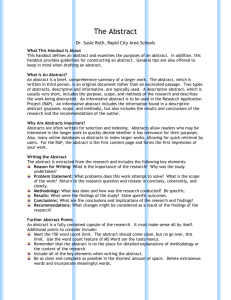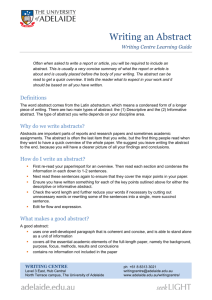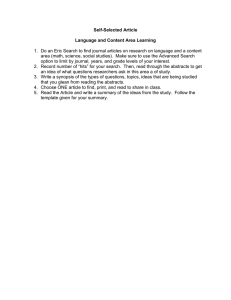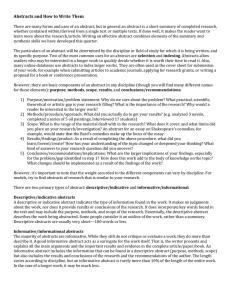Writing an Abstract - Victoria University of Wellington
advertisement
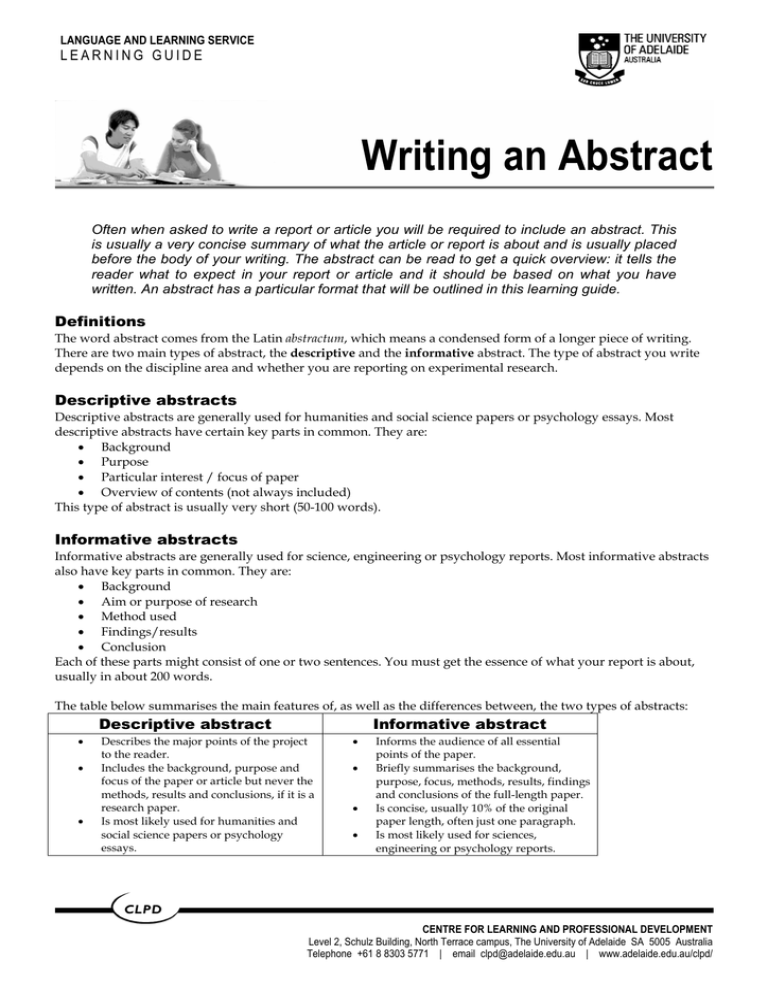
LANGUAGE AND LEARNING SERVICE LEARNING GUIDE Writing an Abstract Often when asked to write a report or article you will be required to include an abstract. This is usually a very concise summary of what the article or report is about and is usually placed before the body of your writing. The abstract can be read to get a quick overview: it tells the reader what to expect in your report or article and it should be based on what you have written. An abstract has a particular format that will be outlined in this learning guide. Definitions The word abstract comes from the Latin abstractum, which means a condensed form of a longer piece of writing. There are two main types of abstract, the descriptive and the informative abstract. The type of abstract you write depends on the discipline area and whether you are reporting on experimental research. Descriptive abstracts Descriptive abstracts are generally used for humanities and social science papers or psychology essays. Most descriptive abstracts have certain key parts in common. They are: • Background • Purpose • Particular interest / focus of paper • Overview of contents (not always included) This type of abstract is usually very short (50-100 words). Informative abstracts Informative abstracts are generally used for science, engineering or psychology reports. Most informative abstracts also have key parts in common. They are: • Background • Aim or purpose of research • Method used • Findings/results • Conclusion Each of these parts might consist of one or two sentences. You must get the essence of what your report is about, usually in about 200 words. The table below summarises the main features of, as well as the differences between, the two types of abstracts: Descriptive abstract • • • Informative abstract Describes the major points of the project to the reader. Includes the background, purpose and focus of the paper or article but never the methods, results and conclusions, if it is a research paper. Is most likely used for humanities and social science papers or psychology essays. • • • • Informs the audience of all essential points of the paper. Briefly summarises the background, purpose, focus, methods, results, findings and conclusions of the full-length paper. Is concise, usually 10% of the original paper length, often just one paragraph. Is most likely used for sciences, engineering or psychology reports. CENTRE FOR LEARNING AND PROFESSIONAL DEVELOPMENT Level 2, Schulz Building, North Terrace campus, The University of Adelaide SA 5005 Australia Telephone +61 8 8303 5771 | email clpd@adelaide.edu.au | www.adelaide.edu.au/clpd/ In both types of abstract your lecturer may require other specific information to be included. Always follow your lecturer’s instructions and modify the above suggestions if necessary. Why do we write abstracts? Abstracts are important parts of academic assignments, most often, reports and research papers. The abstract is the last item that you write but the first one people read when they want to have a quick overview of the whole paper. We suggest you leave writing the abstract as your last section. Produce your abstract when you have finished your paper because by then you will have a clear picture of all your findings and conclusions. What makes a good abstract? An effective abstract: • uses one well-developed paragraph that is coherent, concise and clear and is able to stand alone as a unit of information • covers all the essential academic elements of the full-length paper, namely the background, purpose, focus, methods, results and conclusions • contains no information not included in the paper • is written in plain English and is understandable to a wider audience as well as to your discipline-specific audience • often uses passive structures in order to report on findings, focussing on the issues rather than people • uses the language of the original paper – often in a more simplified form for the more general reader • usually does not include any referencing • in publications (such as journals) is at the beginning of the text but in academic assignments is placed on a separate preliminary page. Steps for writing an abstract 1. 2. 3. 4. 5. 6. First re-read your paper/ report for an overview. Then read each section and shrink the information in each down to one or two sentences. Next read these sentences again to ensure that they cover the major points in your paper. Ensure you have written something for each of the key points outlined above for either the descriptive or informative abstract. Check the word length and further reduce your words if necessary by cutting out unnecessary words or rewriting some of the sentences into a single, more succinct sentence. Edit for flow and expression. Examples of abstracts Here are two abstracts with the key parts identified. The descriptive abstract is for a humanities paper, the informative abstract for a psychology report. 2 Learning Guide © 2005 The University of Adelaide Model descriptive abstract Abstract Key parts The opportunity to design and deliver short programs on referencing and avoiding plagiarism for transnational UniSA students has confirmed the necessity of combating both the "allplagiarism-is-cheating" reaction and the "just-give-them-areferencing-guide" response. The notion of referencing is but the tip of a particularly large and intricate iceberg. Consequently teaching referencing is not adequate in educating students to avoid plagiarism. In this presentation I will use the transnational teaching experience to highlight what educating to avoid plagiarism entails. Background Purpose and aim Particular focus of paper (56 words) (Stevenson, 2004) Model informative abstract Abstract Key parts Metalinguistic awareness contributes to effective writing at university. Writing is a meaning-making process where linguistic, cognitive, social and creative factors are at play. University students need to master the skills of academic writing not only for getting their degree but also for their future career. It is also significant for lecturers to know who our students are, how they think and how we can best assist them. This study examines firstyear undergraduate Australian and international engineering students as writers of academic texts in a multicultural setting at the University of Adelaide. A questionnaire and interviews were used to collect data about students’ level of metalinguistic awareness, their attitudes toward, expectations for, assumptions about and motivation for writing. The preliminary results of the research show that students from different cultures initially have different concepts about the academic genres and handle writing with different learning and writing styles but those with a more developed metalanguage are more confident and motivated. The conclusion can also be drawn that students’ level of motivation for academic writing positively correlates with their opinion about themselves as writers. Following an in-depth multidimensional analysis of preliminary research results, some recommendations for writing instruction will also be presented. Background Purpose and aim Methods Results Conclusions (200 words) (Zoltan, 2005) Learning Guide © 2005 The University of Adelaide 3 How is an abstract different to an introduction? Students are sometimes confused about the difference between an abstract and an introduction. In fact, they are different pieces of writing with different aims and key parts. The following table will briefly describe these differences in the case of a research paper. Abstract Introduction The essence of the whole paper Covers the following academic elements: * Background * Purpose and focus * Methods * Results (also called as findings) * Conclusions * Recommendations (or Implications, not always relevant) Summarises briefly the whole paper including the conclusions. Introduces the paper Covers the following academic elements: * Background * Purpose * Proposition (also sometimes called as point of view or thesis statement) * Outline of key issues * Scope (optional, not always relevant) Introduces the paper and foregrounds issues for discussion. Executive summary This type of writing is very similar to an abstract but has some important differences. • It is usually much longer than an abstract (one to two pages). • It often includes recommendations. • It is most commonly used in an engineering/business context. Further resources University of South Australia http://www.unisanet.unisa.edu.au/learn/ResearchEducation/?PATH=/Resources/researchEducation/research+education/&default=Welcome.htm Weissberg, R & Buker, S 1990, Writing Up Research, Prentice-Hall, New Jersey. If you require more assistance with writing an abstract please contact the Language and Learning Service on 8303 5771. Visit the LLS website for additional resources: www.adelaide.edu.au/clpd/lls/ Learning Guide Authors: Helene Hipp & Patricia Zoltan 4 Template design: Peter Murdoch Learning Guide © 2005 The University of Adelaide
